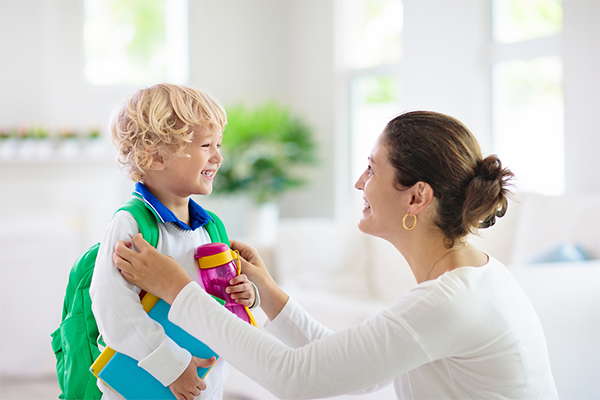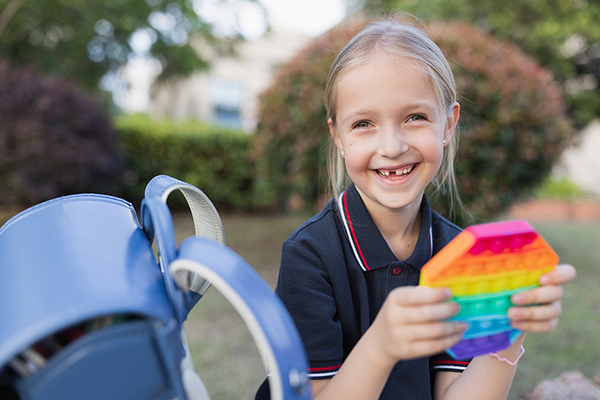More than 90% of parents have never picked up their child’s backpack—or checked what was in it.
So before you even start reading this, try it. Because you might be surprised at how much your child is hefting around every day.
Studies have found that many kids, especially as they enter later elementary or middle school, lug more than 16 pounds on their backs every day—sometimes even up to 30 pounds.
Dr. David Cearley, a pediatric orthopedist at the Children’s Hospital of Georgia, sees it all the time during the school year—lower back and shoulder pain from kids struggling with too-heavy backpacks. “I encourage parents to watch their children walk with their backpack. If they’re hunched over or struggling, parents and kids need to look at the backpack and try to see if they can take stuff out.”
How Much Is Too Much?
Experts agree that kids should carry about 10% of their body weight on their backs—and no more than 20%.
That means that if your child weighs 60 pounds, their backpack should weigh about 6 pounds, but no more than 12 pounds. If it helps, think about this: A standard 500-page textbook weighs about 2.5 pounds.
Why So Heavy?
Most kids today usually lug around everything they need for their classes, all day long. And there are two big reasons why. First is the fact that today’s schools offer less time between classes. And if your child’s school has a big campus, where classes can be far apart, it’s less worry to just carry everything than risk the chance of being late and getting in trouble.
Second—and related to the first—is the fact that some schools don’t even offer lockers anymore, since children aren’t using them.
Pack Light
“I hardly ever see children for backache in the summer,” said Cearley. “But during the school year? It’s every day of the week in clinic; I’ll see at least one person with back pain.”
So how can parents keep heavy backpacks from being a literal pain in the neck?
• Start by lightening the load. “Kids tend to want to have this and that with them at all times, but those may be things that can be taken out,” said Cearley. “Make sure the packs only have what kids absolutely need.”
• Pack smartly. Kids should load the pack so that the heaviest items are closer to the back.
• Practice backpack safety. Backpack straps should be cushioned and should fit snugly so that the bottom of the backpack sits at your child’s waistline, not hanging or drooping down. While it may not be cool, “Put the backpack over both shoulders, not one,” said Cearley, and if available, use a waist strap. The safest way to put on a backpack is for a parent to put it on a child, but that’s not always possible. So teach your child to pick it up safely, squatting so they’re lifting with their knees, and then to carefully slide one arm in at a time. Or, your child could even place the backpack on a waist-height table and slide it on his or her shoulders from there.
• Think outside of the pack. If those don’t work, parents can also consider investing in a lighter backpack (since the pack itself can be heavy, especially if it has a leather bottom) or a rolling backpack if schools allow them (some schools require a doctor’s note). If your child’s school doesn’t offer lockers, parents can ask about the possibility of storing books in a classroom; some schools also offer shared cubbies that kids can use throughout the day.
Keep Backpacks From Being a Pain
When Dr. Cearley sees kids in clinic for back pain, he starts by asking what the pain feels like, how bad is it, and how much does it limit their activity or keep them up at night.
If it started by carrying a backpack for school, he’ll do an X-ray to rule out any other problems. “But if everything checks out, it’s usually muscle strain,” he said.
Along with lightening the load and looking for other options, Cearley advises treating existing pain with heating pads for 20 minutes at a time and stretching. “If kids are active and exercising, decent core strength shouldn’t be an issue,” said Dr. Cearley. “But add in exercise if they aren’t.”
And in news that kids everywhere will agree with: “School is the number-one cause of backaches for kids and adolescents,” said Cearley. “Sitting all the time and carrying a backpack twice as heavy as it should be is a bad combination.
“But, the good news is that there’s no evidence that carrying a heavy backpack in no way induces, encourages or worsens spinal deformity. In other words, there’s no scientific evidence that a heavy backpack causes a long-term problem. Typically, once kids stop carrying a too-heavy backpack, pain does go down significantly.”
The Children’s Hospital of Georgia has the largest team of general pediatricians, adolescent medicine physicians and pediatric specialists in the Augusta area. For more information, visit our website at augustahealth.org/kids or call 706-721-KIDS (5437).




